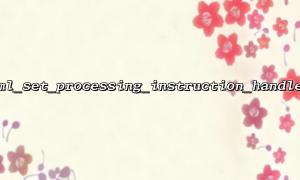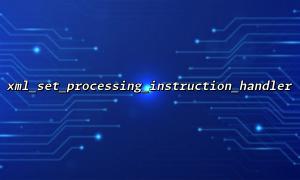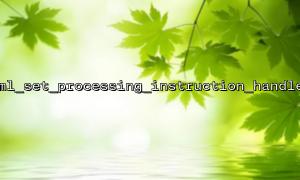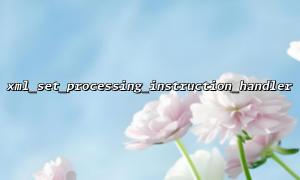In PHP, xml_set_processing_instruction_handler is a function used to handle XML processing instructions (Processing Instructions, abbreviated as PI). It allows developers to intercept and process specific processing instructions when parsing an XML document. Processing instructions are a special XML syntax typically used to embed application-related information into the document, which is not directly presented to the user.
In an XML document, processing instructions are content enclosed by and ?>. They are usually used to convey specific information to applications processing the XML, but do not directly affect the structure of the XML data. For example:
<?php echo "Hello World"; ?>
One of the main uses of processing instructions is to embed instructions in the XML document to indicate how to handle certain content or provide additional metadata for specific applications.
xml_set_processing_instruction_handler is a function in PHP that sets a callback function to be called when the XML parser encounters a processing instruction. The basic syntax of this function is as follows:
bool xml_set_processing_instruction_handler ( resource $parser, callable $handler )
$parser: An XML parser resource created by xml_parser_create() or xml_parser_create_ns().
$handler: The callback function for processing instructions. This callback function will receive three parameters:
$parser: The XML parser resource.
$target: The target part of the processing instruction.
$data: The data part of the processing instruction.
To use xml_set_processing_instruction_handler, the following steps are typically required:
First, we need to create an XML parser:
$parser = xml_parser_create();
Next, define a callback function that will be called when the XML parser encounters a processing instruction:
function handle_processing_instruction($parser, $target, $data) {
echo "Processing instruction: Target = $target, Data = $data\n";
}
This callback function will output the target and data parts of the processing instruction.
Use xml_set_processing_instruction_handler to set the callback function:
xml_set_processing_instruction_handler($parser, "handle_processing_instruction");
Next, you can begin parsing the XML data:
$xml_data = '<?xml version="1.0"?>
<?php echo "Hello World"; ?>
<root>
<child>Example</child>
</root>';
<p>xml_parse($parser, $xml_data);<br>
In the XML, <?php echo "Hello World"; ?> is a processing instruction that will trigger the callback function handle_processing_instruction.
Finally, close the XML parser:
xml_parser_free($parser);
Processing instructions are often used to embed application-related configuration information into an XML file, information that does not need to be processed by the XML parser. By using xml_set_processing_instruction_handler, developers can capture this information during parsing and process it as needed.
For example, in a large XML configuration file, there might be processing instructions like this:
<?config version="1.0"?>
<settings>
<setting name="theme">dark</setting>
<setting name="lang">en</setting>
</settings>
Developers can process this configuration information in the callback function:
function handle_config($parser, $target, $data) {
if ($target == "config") {
echo "Config Data: $data\n";
}
}
During XML parsing, the processing instruction will trigger the handle_config function, where the data part can be extracted and processed.
If multiple processing instructions need to be handled, different callback functions can be used. You can call xml_set_processing_instruction_handler multiple times and differentiate the handling logic based on the target of the processing instructions.
For example:
function handle_config($parser, $target, $data) {
if ($target == "config") {
echo "Config: $data\n";
}
}
<p>function handle_license($parser, $target, $data) {<br>
if ($target == "license") {<br>
echo "License Info: $data\n";<br>
}<br>
}</p>
<p>xml_set_processing_instruction_handler($parser, "handle_config");<br>
xml_set_processing_instruction_handler($parser, "handle_license");<br>
xml_set_processing_instruction_handler can only be used when calling xml_parse or xml_parse_into_struct, and requires the XML document to contain processing instructions.
Once a processing instruction is parsed, the callback function will be automatically called. If the parser does not encounter any processing instructions, the callback function will not be triggered.
If there are multiple processing instructions of the same type, the callback function will be called sequentially according to the defined order.
xml_set_processing_instruction_handler provides PHP with a powerful mechanism for handling processing instructions in XML documents. By defining a callback function, we can capture specific instructions and process them as needed. This approach is especially useful when dealing with configuration files, metadata, or integration with other applications.
Related Tags:
XML


